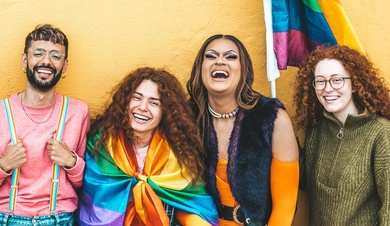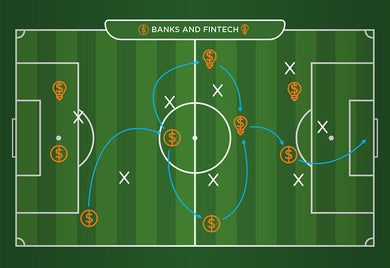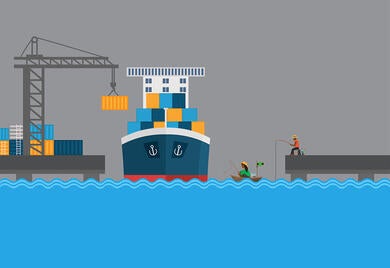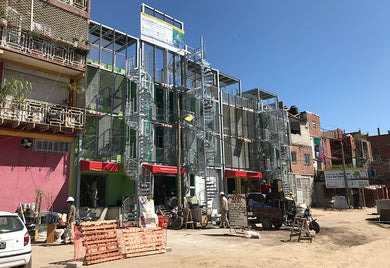
LGBTQ+ Inclusion in the Workplace: A Business Imperative for Latin American and the Caribbean
The inclusion of the LGBTQ+ community in the business environment is imperative to improve staff retention, employee satisfaction, and productivity.

Unity is strength
The irruption of new players in the global commodities trade, greater consolidation of the multinationals, and the effects of climate change are forcing agricultural producers in Latin America and the Caribbean to rethink their strategies for minimizing risks and maximizing results on a sustainable basis. Realities and opportunities Although the research and development (R&D) investments of the “Big Four” (Bayer-Monsanto, ChemChina-Syngenta, Dow-Dupont, and BASF) achieved scientific advances that transformed global agriculture, expanded the agricultural frontier, and increased yields, producers face a dependence on technology and prices that is difficult to mitigate. Although in grains, companies like China’s COFCO or Japan’s Marubeni challenge the power of the ABCD (ADM, Bunge, Cargill, and Dreyfus), and demonstrate the strategic importance of ensuring the supply of commodities for some countries. In this fight, it is likely that corporate acquisitions will continue, or that new commodities platforms will be developed, creating opportunities for groups of producers, cooperatives, or business associations. Finally, the effects of climate change (rains, droughts, frosts, floods, cyclones, reduced aquifer flows, and new diseases) are affecting the producers’ profits, particularly in Central America where the narrow strip of land between two oceans makes climatic distortions even worse. Various ways to partner It is an historic reality that agricultural producers take the greatest risks but capture the smallest piece of the pie because of their fragmentation, difficulties in accessing financing, and minimum added value. However, producer partners in cooperatives that adapted to the dynamics of the market, through internal transformations (including advances in the management of corporate governance), were able not only to improve their incomes, but also to become part of a sustainable business, like Copersucar in Brazil, Conaprole in Uruguay, ACA in Argentina, FNC in Colombia, Colonias Unidas in Paraguay, or Dos Pinos in Costa Rica. In the case of independent larger-scale producers, although they will be able to maintain a certain individualistic profile internally to obtain efficiency and productivity, improving the external profitability is a must. They could take their inspiration from the spirit of cooperatives to create partnerships leveraging their combined volume (with increasing strategic value) and obtaining better conditions, or even process it for greater added value. For example, in Argentina, the 30 partnered producers of Bio4 transform their own and third-party corn to produce ethanol, and the “L” Group partners to sell milk. Similarly, in Mexico, the partnered producers of Proaoass and Gradesa export bread wheat or durum wheat. Although the greatest challenge for farmers under this model was to remain united, and in some cases to delegate the management of the new business to third-party professionals, they were also focused on obtaining better economic results, and also to develop a platform to start new businesses and obtain market intelligence. Looking ahead It is likely that differences in results among producers of a similar scale are due to: (1) more collective than individual actions; (2) a more business-like profile for sustainable production; and (3) the management of individuals or teams that applied the best technology packages. Considering that quasi-state companies, and sovereign funds from Asia-Pacific and Middle East countries are seeking alternatives to ensure the food supply, soon it would not be utopic to think that networks of partnered producers or cooperatives may develop strategic alliances to have their own ports, freezers, or powdered milk plants. Moreover, since these investments require long-term financing, it would not be unrealistic to think that development banking will be financing these projects. As Seneca said: “It is not because things are difficult that we do not dare, it is because we do not dare that things are difficult.” Subscribe to receive more content like this! [mc4wp_form]

Shared value takes off
The airport industry is key to the growth of air travel in Latin America. This industry generates 5.2 million jobs that add $167,000 million to the region’s gross domestic product annually. Projections indicate that during the next 20 years this industry will create 99 million jobs around the world. For example in Quito the Mariscal Sucre International Airport was built in 2013 as a private undertaking that, with the IDB Group support, would play a strategic role for this industry in the region. However, modern airports are much more than air transport terminals. They have become “development hubs where other air transport-related or complementary activities converge”, as we have already discussed. A ticket to local food It is increasingly evident that more airport operators and investors realize that environmental and social sustainability has become an investment opportunity that makes financial sense, generating significant benefits for sustainable development. Quiport S.A. — the private operator of the Quito airport — has not been an exception to the rule, and they approached us with a challenge in mind: how to share the value of this development with the local community? The first step was to support the company in conducting a shared value assessment, which allowed us to determine the current and potential resources available. Based on this analysis, Quiport decided to focus on three initiatives to improve both the company and community sustainability by establishing a community-based recycling organization, creating an aviation training center, and supporting the program development of Nuestra Huerta, helping local food producers to be involved in the airport activities. Over the last two years, IDB Invest has supported Nuestra Huerta with business, marketing, and execution trainings, including orientation regarding legal permits for food vending. Thus, the cooperative went from selling fruits and vegetables on a weekly basis to only 100 direct employees of Quiport, to selling more than 36 products to the 7,500 airport workers. Growth has been such that an online platform was created to place orders. Today, this program has benefited not only farmers, but also airport workers who can purchase fruits and vegetables in their workplace. Furthermore, Nuestra Huerta expects to open a store in the airport to sell their product to tourists. Shared value, multiplying effect on profits The Quiport project clearly shows that, in addition to any efforts and work aimed at including the community for the sake of sustainability, one of the most significant outcomes from this project are seen in the company´s positive bottom line. Even though it was not an initial project goal, the upcoming opening of a Nuestra Huerta store will generate a modest return for the airport. Currently, the company is developing recycling initiatives and an aviation training center. The recycling effort will allow the company to save in waste disposal costs, and generate some marginal income from the sale of recyclable materials. As for the training center, customer service will improve at the airport. IDB Invest is committed to working with the private sector to foster sustainable development in Latin America and the Caribbean. We seek investment opportunities that will bring about benefits to communities and companies, as we have done with the shared value assessment for the Quito project. It is not always easy to identify these opportunities, and it is even more challenging to move them forward, but Quiport is a good example that every effort has its reward. So, how do you share the value of your company? Subscribe to receive more content like this! [mc4wp_form]

What can Messi, Neymar and Suarez tell us about banks and fintech companies?
On May 26, 2013, a tweet from FC Barcelona confirmed that the 21-year-old Brazilian striker Neymar Jr. had accepted a multi-million dollar contract to join five-time Ballon d’Or winner Lionel Messi in the Catalonian soccer team. Fourteen months later, the same club hired the Uruguayan star Luis Suarez. A couple of weeks later, Barcelona’s legendary player Johan Cruyff suggested that the new hiring could ruin the team: “The three of them are too individual; I can't see how Barça intends to continue playing…” Fintech firms, the emerging financial service sector of the 21st century, are flourishing across Latin America and the Caribbean with no exception. The Inter-American Development Bank and Finnovista have identified more than 700 Fintech firms in 15 out of 18 countries in the region. Bullish observers believe the emergence of Fintech companies represent the end of traditional banks; the skepticals claim Fintech firms are not meant to last. Though it is difficult to anticipate how tech innovation will shape financial intermediation in the future, market participants have more to win in a collaborative “ecosystem”, rather than playing a zero-sum game. Business opportunities are huge for all participants and every player has something to bring to the table. The field for FIs and Fintech firms in the region Credit still represents, on average, less than 45% of the gross domestic product (GDP) in Latin American and Caribbean countries, well below the average 150% in developed countries. For example, in Argentina, one of the richest countries in the region, credit represents less than 15% of GDP. On top of this, half of the adults in the region do not have a banking account and, in some countries, such as Nicaragua or Peru, this ratio hits three out of four citizens. Cash continues to be the most used mean of payment in the region with 90% of utilities paid in cash, according to some studies. [clickToTweet tweet="Credit represents less than 45% of the GDP in #Latam and #Caribbean countries" quote="Credit represents less than 45% of the GDP in Latin American and Caribbean countries" theme="style1"] However, the region benefits from a huge advantage: technology adoption is incredibly fast. Mobile penetration reaches 70% of the population, comparing relatively well with the 84% enjoyed by Europe, the world’s most developed continent mobile-wise, according to GSMA. On top of this, Latin America is expected to be the second fastest growing mobile market in the next five years, setting the perfect platform for fintech companies’ growth. Fintech firms’ biggest assets are their accessibility through digital and mobile channels, their agility and velocity to adjust to a changing environment, and their capacity to maximize the customer experience. According to Capgemini, almost 70% of costumers would refer their fintech service provider to a friend, but roughly 45% to their bank. On the contrary, though the gap is closing, traditional banks take the lead when talking about trust. 60% of consumers completely trust their banks, no matter the quality of the service, indicates the study. In the same line of thinking, although fintech companies are gradually diversifying their funding sources, banks have a wider reach in terms of access to capital and cheap and stable retail deposits. And banks also benefit from the regulators’ blessing. A new game strategy for Latin America and the Caribbean At the Inter-American Development Bank Group (IDB Group), we believe collaboration should be the rule and not the exception. That’s why, in the context of the 2017 Mobile World Congress, we launched FINCONECTA, a 10-month program dedicated to create the first interconnected ecosystem of solutions between financial institutions and leading fintech firms to foster the exponential growth of the financial industry. The results will be announced in the FOROMIC 2017, to be held at the end of October in Buenos Aires. [clickToTweet tweet="1 out of 3 #banks operating in #Latam are already partnering with #fintech companies" quote="One out of three banks operating in Latin America are already partnering with fintech companies" theme="style1"] “Messi knows that the players around him make him a better player, and he makes his mates better too,” affirmed former Barça’s head coach Luis Enrique in an interview. In the last three seasons, Messi, Neymar, and Suarez have scored more than 300 goals by playing together. According to a study conducted by PWC, one out of three banks operating in Latin America are already partnering with fintech companies, and more than 80% expect to be doing business together in the next three to five years. The ball is rolling. It’s time to let banks and fintech firms play together and consumers will be as happy as Barcelona’s fans. You can also see more on the impact of the fintech revolution in Latin America and the Caribbean on this full report. Subscribe to receive more content like this! [mc4wp_form]

Making social investments count
When someone searches the word “sustainability” online, images of wind farms, trees, and waterways dominate the results. What is often missing from these photographs are people. It remains a challenge to break the habit of equating sustainability just with the environment. Sustainability, at its core, is something that should conjure not just these images but illustrations depicting people and the benefits of a positive healthy community. The private sector, in particular, should desire sustainable communities since this can often translate into better economic performance. According a study conducted by Deutsche Asset Management and the University of Hamburg, there is a positive correlation between good environmental, social and governmental practices and improved corporate financial performance. In other words, it literally pays to incorporate sustainability at the core of one’s primary business. An example of this is the Kingston Freeport Terminal Limited (KFTL) sustainable program at the Kingston harbor, in Jamaica. After winning the 30-year concession to operate the Kingston Container Terminal, KFTL saw an immediate need to seek out partners to become the catalysts for development in the harbor. Making room for sustainable infrastructure The first field visits to KFTL were challenging. I arrived at Greenwich, one of the largest fishing beaches in the harbor, to be immediately struck by the complexity of its location. Situated between the harbor and the state oil refinery on a slim piece of land, I wondered how these two could coexist. The visible conditions were extremely poor: no basic infrastructure and a landscape dotted with makeshift wooden shacks. Despite this, there was a real community there; fisherfolk (as they are called in Jamaica), who for several generations have made their livelihood from fishing these waters, have adapted to an extremely challenging environment. They are the largest —more than 4,000— and most economically vulnerable stakeholder. [clickToTweet tweet="Private sector should desire sustainable communities since they improve economic performance" quote="Private sector should desire sustainable communities since they improve economic performance" theme="style1"] As we began our conversations with the fisherfolk the tension was clear. The main concern was about the impact in their business, since previous experiences negatively affected their fish catch for more than a year. To define a social investment strategy and successfully structure the deal, IDB Invest (formerly known as Inter-American Investment Corporation) began working with KFTL. The purpose was to help the company to develop a long-term sustainability approach to ensure that investments produce benefits not only to private sector companies working with us but also to society. Coming to a sustainable agreement KFTL concession allows the company to modernize the harbor and to conduct dredging operations to receive larger Panamax vessels, which are designed to pass through the Panama Canal. These operations will increase employment opportunities for the surrounding communities, and help port operators engage with other stakeholders to ensure long-term sustainability for all harbor users. However, the creation of a long-term sustainability program was also a main objective for the company. This will be paramount to enhance relationships among port stakeholders, and invest in improving fisherfolk conditions. To increase social inclusion and incentivize an open dialogue, we recommended the creation of a committee with the fisherfolk fishing beach representatives, the Jamaican Port Authority, and KFTL staff. The committee has defined three main activities to revitalize the harbor: 1) provide livelihood support during dredging activities; 2) conduct solid waste cleanup of fish nurseries within the harbor; and 3) develop a fish sanctuary and artificial reef outside the harbor. These programs are still in their planning phases. However, their investments will provide long-lasting benefits to a community that has experienced declining incomes and economic vulnerability for years. On the business side, the 830 government workers from the port were employed by KFTL, and as container traffic increases additional labor growth is expected. Moreover, since the handover an additional 40 staff have been hired in various positions throughout the company. Ultimately, KFTL commitment will help shaping what it means to be a sustainable company while simultaneously providing a tangible improvement to an extremely vulnerable population. This is one clear example of how the private sector can leverage its resources to create economic benefits not only for itself, but also broad societal benefits for key stakeholders. Subscribe to receive more content like this! [mc4wp_form]

How we incentivize social inclusion through Sustainable Infrastructure? The case of Villa 31
Recently I visited the Villa 31 in Buenos Aires, Argentina. It is a poor and informal neighborhood located at approximately 500 meters from La Recoleta, one of the most sophisticated areas of the Argentinian capital. Despite this proximity, near 45,000 residents at Villa 31 have lived in isolation, not accepted as true “porteños” by their neighbors due to the social and economic characteristic of their community. My hope is that a new development project of sustainable infrastructure in the area changes this scenario. During my visit, I met fantastic people, but I experienced a strong mix of feelings. 20 years ago, I worked on an urban rehabilitation project in Brazil, which provided new homes, electricity, water, and sanitation to hundreds of low income people. By the end of the project, high-level dignitaries from the Government and other entities visited the new homes. One of them approached a woman benefited by the project and asked: “Are you happy? Is your life better?” She looked at him and said: “No, I am much worse off today. Before the project, I lived in a shack, I had no light, no water, no job, but no bills either. Now I have been given this nice house with bills to pay, but I still do not have a job. I do not know what to do”. 20 years after, I still carry this experience with me, even though we have learned a lot about urban development and inclusion projects ever since. The number of success stories has been growing, but its nature remains rather complex and represents a significant challenge to governments, policy makers, and financiers alike. According to an Inter-American Development Bank report: “Poverty-targeted projects that did not include specific objectives to reach excluded populations often reinforced their exclusion”. We must avoid this at all cost and work on the inclusion since the beginning. From Villa 31 to Villa “Thirty and Everyone” Working on sustainable infrastructure is not only about building new houses, but to improve the entire ecosystem around them to mobilize more human and economic resources that help people to break the poverty cycle. Villa 31 is not an isolated case. In Latin American and the Caribbean cities, informal areas can concentrate up to 50% of its habitants, and according the estimates, these number will keep rising. Development processes must include habitants’ perspective. Local communities have a voice, and the fact that we are listening to them makes a huge difference in terms of long-term acceptance, appropriation and viability. During my days at the Villa, I saw the construction taking place and the physical infrastructure being implemented. The work on water, sanitation, accessible roads, energy and electrified systems at Villa 31 is allowing its inclusion into Buenos Aires. More importantly, I saw people smiling and the pride on their eyes not only for the new structures, but for having a voice and being really included. So much that the initiative has been called Treinta y Todos (“Thirty and Everyone”) by Horacio Rodríguez Larreta, Buenos Aires city Mayor. This project has renewed people’s belief that their children would have the opportunity to live a different and better life, which is an essential success factor in such complex situation. Walking the talk at the Villa The feeling when leaving Villa 31 was completely different to what I felt 20 years ago, after our conversation with that woman in Brazil. I saw a high sense of trust and hope, so high that residents are already investing their own capital on improving their homes and establishing new business, such as: restaurants or beauty shops. Complementary initiatives like these are key, considering near 70% of the urban population of Latin America and the Caribbean works in the services sector, according UN-Habitat. A new socio-economic dynamic is developing, and some important external factors are fueling the process forward. The decision to establish a major government office building from the Education Ministry at the Villa provides a strong signal. However, it is not the only one. At the Inter-American Development Bank Group (IDB Group) we firmly believe in ‘walking the talk’, and the construction of the new Argentinian representation in Villa 31 shows it. This is a bold sign of commitment to the country and, more importantly, to the people. As part of the IDB Group, IDB Invest (formerly known as Inter-American Investment Corporation) is mobilizing resources and creating financial tools to stimulate private investments on these projects. Other public and private institutions should learn about the changes at the Villa, and hopefully decide to stand up and support this process too. [gallery type="slideshow" link="file" size="full" ids="7752,7753,7755,7757,7758,7759"] Subscribe to receive more content like this! [mc4wp_form]